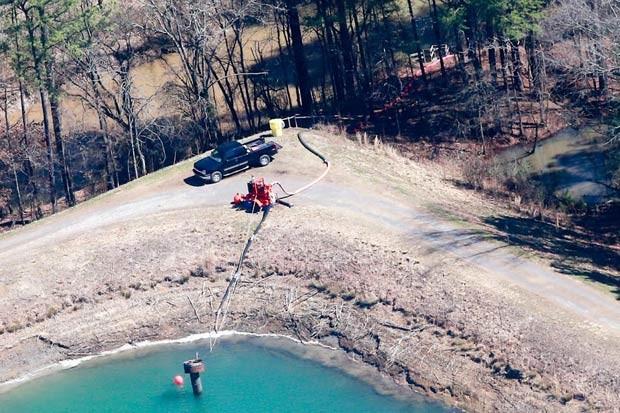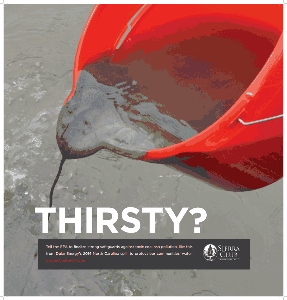First, listen to this week’s excellent Green Divas myEARTH360 podcast . . .
Green Divas – myEARTH360 Report 3.19.14
This week in environmental news, there’s toxic sex, toxic spills and ways to take action against such things
If you happen to use lube in the bedroom (if you know what I mean), you might want to use your bedroom eyes to read the label before getting busy.
Why? Because most intimate-use products—especially personal lubes—contain toxins like parabens, sodium benzoate, glycerin, petrochemicals and even propylene glycol—a common ingredient in brake fluid! Not the kind of fluids one would expect to find in an intimate moment. (Want to learn more about toxins in our every day lives? Check out the documentary Unacceptable Levels.)
Speaking of fluids . . .
Duke Energy was just caught pumping wastewater from two toxic coal ash lagoons into a canal that drains into Cape Fear River, thanks to aerial surveillance photos released by WaterKeeper Alliance. The river feeds drinking water sources downstream. Duke not only admits to the pumping, they say it was part of routine maintenance allowable by permit and they’ve been doing it since the fall of 2013! What? Back in February, they spilled tens of thousands of tons of coal ash (a toxic pollutant) into North Carolina’s Dan River—the third largest spill of its kind in U.S. history.
Do not despair—there’s some encouraging news. The increased competition for water between different industries is forcing oil and gas drillers to invest in on site water treatment. That means treating wastewater and re-using it instead of irresponsible dumping plus potentially putting less of a drain on this precious resource. With the big oil’s deep pockets, it’s the perfect storm for testing water treatment technologies that would otherwise evaporate due a lack of funding.
Read on for those and other environmental news headlines…
WTF News…
Are you having Toxic Sex?
Many of are conscious about the food we eat and the lotions, creams, ointments and beauty products that come in contact with our skin every day.
Yet our awareness may be a bit skimpy when it comes to potential toxin exposure in the bedroom department. You could be having toxic sex.
Okay, so maybe we’re thinking about other things (when we’re busy getting busy?). But, unfortunately, it’s time we turn those bedroom eyes toward your intimate-use products—most of them are chock full of toxic ingredients like parabens, sodium benzoate, glycerin, petrochemicals and even propylene glycol—a common ingredient in brake fluid!
Recent studies have also shown that many such products—especially personal lubes—can seriously damage the cell lining, potentially enhancing our susceptibility to sexually-transmitted bags o’ fun like gonorrhea, Chlamydia, syphilis, genital herpes, hepatitis B and, of course, HIV. But more on that in a bit. Read more…
Duke Energy Caught Dumping Wastewater from Coal Ash Lagoon Into Local Watershed
Waterkeeper Alliance released aerial surveillance photos taken from a fixed-wing aircraft last week which show Duke Energy workers pumping wastewater from two of Duke Energy’s toxic coal ash lagoons into a canal that drains into the Cape Fear River.

The revelation comes less than two months after the Dan River disaster, where at least 30,000 tons of coal ash spilled from another of Duke Energy’s toxic coal ash lagoons. The pumping also came just days before a federal grand jury convenes in Raleigh to hear evidence in a criminal investigation of Duke Energy, the North Carolina Dept. of Environment and Natural Resources (DENR) and the handling of coal ash.
In these revealing stories in Sunday’s New York Times and Monday’s Los Angeles Times, Duke Energy admitted its workers were pumping coal ash wastewater out of a toxic wastewater pond and into a canal which drains into the Cape Fear River. The Cape Fear River is a source of public drinking water for residents in Fayetteville, Sanford, Dunn, Harnett County, Fort Bragg and Wilmington. View more photos and ead the full story here and a recent update here.
Killer dust: why is asbestos still killing people?
A long vertical pipe sits against white-painted brickwork in the corner of a cramped storeroom. Two men wearing orange boiler suits and gloves crouch at its base. One uses a scraper to remove lumps of what looks like wet papier-mâché from the outside of the pipe, into a red bag held by the other.
Both men are breathing through face masks, their air sucked from outside the isolation unit: a short, makeshift corridor constructed from black plastic panels and transparent polythene sheeting. An extractor fan hums relentlessly.
It might look like a scene from a horror movie in which scientists fight to contain a virus, but the truth is more banal – though no less deadly. The two men are removing asbestos insulation from a heating pipe in a west London hospital. Read the full story…
Listen to the Green Divas interview with Linda Reinstein, President/CEO and Co-Founder of Asbestos Disease Awareness Organization (ADAO) HERE.
Americans Most Likely to Say Global Warming Is Exaggerated
Even as most Americans report experiencing abnormal weather conditions lately, more than four in 10 say the seriousness of global warming is generally exaggerated in the news. These sentiments are lower than the record 48% who believed this four years ago, but higher than any year before Barack Obama became president.
Trend: Is the seriousness of global warming generally exaggerated, generally correct, or generally underestimated in the news?
Though the largest share of Americans specifically describe reports on the seriousness of global warming as exaggerated, a slim majority collectively see these reports as generally correct (23%) or generally underestimated (33%). On this basis, most Americans seem to accept that global warming is at least as serious a problem as news reports say it is. Viewed still another way, fully three-quarters of the country believe that reports about global warming are mistaken — for better or worse.
Nasa-funded study: industrial civilisation headed for ‘irreversible collapse’?
A new study sponsored by Nasa’s Goddard Space Flight Center has highlighted the prospect that global industrial civilisation could collapse in coming decades due to unsustainable resource exploitation and increasingly unequal wealth distribution.
Noting that warnings of ‘collapse’ are often seen to be fringe or controversial, the study attempts to make sense of compelling historical data showing that “the process of rise-and-collapse is actually a recurrent cycle found throughout history.” Cases of severe civilisational disruption due to “precipitous collapse—often lasting centuries—have been quite common.”
“The fall of the Roman Empire, and the equally (if not more) advanced Han, Mauryan, and Gupta Empires, as well as so many advanced Mesopotamian Empires, are all testimony to the fact that advanced, sophisticated, complex, and creative civilizations can be both fragile and impermanent.”
Encouraging Environmental News…
Fracking: the surprising new proving ground for water technologies
Big advancements in wastewater treatment could be coming from an unexpected source: the oil and gas industry.
The growth of fracking brings with it a heavy demand for water, and that’s straining water supplies, often in drought-prone areas. The conflict over water has fueled adoption of new water reuse and recycling techniques, making the fracking market a valuable new proving ground for these technologies – which could later be used in other industries, experts say.
“There’s a lot of money,” says Monika Freyman, the water program manager at shareholder activist group Ceres. “Big and small innovative companies are chasing this area.” Read the full story…
The Navy’s Plan to Beam Down Energy From Orbiting Solar Panels
For decades, the Pentagon has been the world’s largest oil consumer, and as global petroleum prices continue to rise, the military has been searching for feasible energy alternatives. Now they’re looking in space.
The U.S. Naval Research Laboratory (NRL) is building technology that will allow the military to capture solar power in orbit and project it back down to Earth. Not only would space solar potentially save the Pentagon buckets of cash, but it could simplify military deployments. Fuel tankers would no longer have to reach remote or volatile areas, and missions could run longer without having to return to base to refuel.
So far, NRL has built and tested two different prototypes of what they call a “sandwich” module, named for a design innovation that packs all the electrical components between two square panels. The top side is a photovoltaic panel that absorbs the Sun’s rays. An electronics system in the middle converts the energy to a radio frequency, and the bottom is an antenna that transfers the power toward a target on the ground. Read the full story…
This New Media Trend Will Leave You Optimistic About The Future
As climate change coverage has been suffering in mainstream media, alternative, web-based media sources are starting to give more attention to the issue of global warming.
On March 10, Upworthy released the findings of a poll of its readers on what topic they wanted more coverage of — the number one answer was climate change and clean energy. This is the latest in a trend of new media sources actively working to provide more coverage of global warming, in contrast to traditional media that are providing “shockingly little” coverage to a “critically important issue.” Meanwhile, to receive their news content Americans are turning increasingly away from papers and TV, and towards web-based sources, a term collectively known as “new media.”
A paper from the Yale Forum on Climate Change & Media found that web multimedia is “poised to reshape news coverage on science and climate,” telling of a burgeoning opportunity for climate change stories — that “the time for new media has come”:
“[Mainstream media] has been doing things the same way for so long you can’t be imaginative,” says Nicholson, a New York-based science journalist. As television and the Internet merge, she sees coverage taking on forms fully adapted to the possibilities of digital production. “It’s going to be fast, social and everything will be mobile,” she says. “We have an opportunity to change the way we tell stories.” Read the full story…
Green Divas Action of the Week!
The Sierra Club just launched a new toxic coal ash pollution campaign urging the Environmental Protection Agency to put strong coal ash water pollution protections in place this year.
Read about the campaign and add your voice to the petition here.
Hungry more environmental news? Check out last weeks’ myEARTH360 report here.
Earth image via shutterstock.


